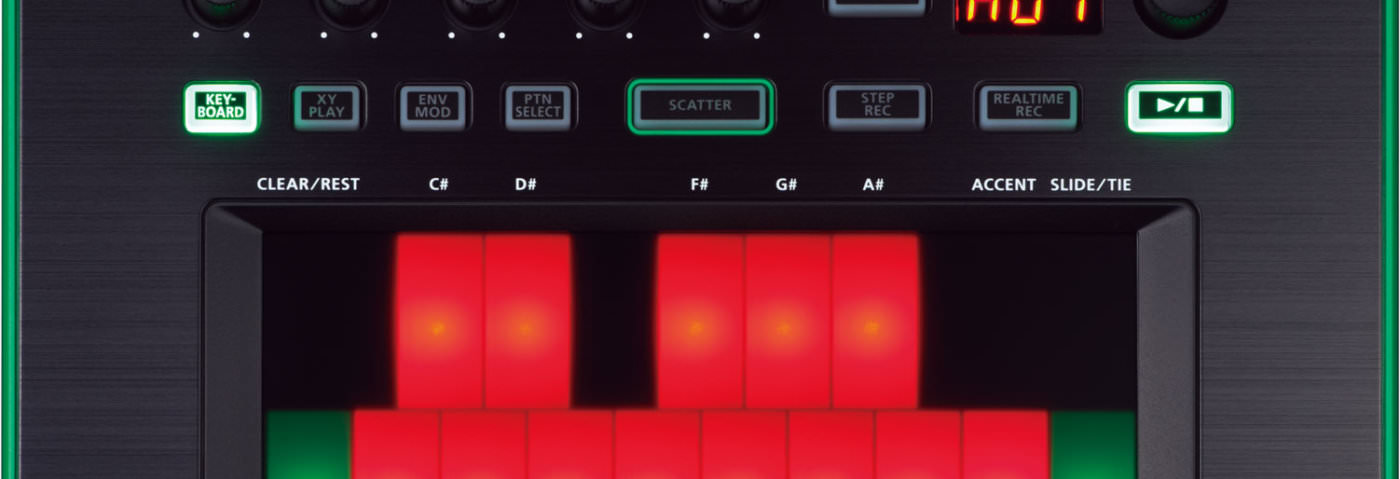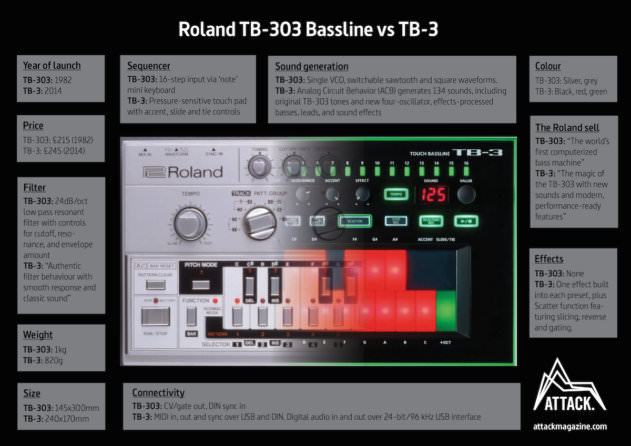Sound
So, does the TB-3 sound like the 303? In a word, yes – but that’s only a small part of the point of the TB-3. It’s probably not as close to the 303 as a TT-303 or good x0xb0x, but it’s certainly very much in the right ballpark. However, 303 imitations are only a small part of the sound palette. The TB-3’s presets include detuned basslines, stacked unison leads and echo-laden FX.
There are plenty of options to choose from, but it’s important to note that the presets can’t be edited in any way other than adjusting the depth of the effect. The effect can’t be switched, either; if you find the perfect sound but it’s got a reverb on it you can’t switch it to a delay. Scatter, controlled independently, is a similar stutter, reverse and gating effect to that found on the other AIRA models.
There’s an inevitable Korg comparison here, but it’s not the obvious one with the Volca Bass. Instead it’s the Kaossilator, which features a similar preset-based synth engine with a touchpad-controlled loop sequencer. The TB-3 can be considered a similar kind of product: it harks back to the 303’s basic sequencing approach and offers hands-on controls of a very small number of parameters rather than necessarily imitating the sound itself.
Conclusion
It only takes a few seconds with the TB-3 to realise that this is a case of Roland updating an old concept rather than recreating the original product for the AIRA range. Beyond the first two presets – which are obvious 303 emulations – you’ll discover a range of sounds which expand way beyond the capabilities of the 80s original. The TB-3 is inherently preset-based: there’s no way to edit patches or adjust the basic configuration of the virtual analogue oscillators. Nevertheless, the range of sounds here complements the sequencer well, allowing you to take advantage of its appealing approach to creating and manipulating simple loop-based patterns.
So, don’t think of it as a new 303 in terms of sound, but as a contemporary take on the classic groovebox concept. As Roland’s marketing succinctly puts it: “It’s the TB… evolved.”
The Verdict
Price: £245
Purchase: AIRA TB-3 Touch Bassline
The Final Word
A fun creative tool, but restricted by the preset-based sound engine.


04.51 PM
I think it sounds the dog’s proverbial. Really excited to buy one.
12.12 AM
I thought the original TB-303 was an 18db/Oct filter?
08.37 AM
@ Mr Mysterioso – it’s a common misconception, largely because Roland described it as an 18dB/oct filter when it isn’t. Tim Stinchcombe explains it in detail here (summarised below).
http://www.timstinchcombe.co.uk/index.php?pge=diode
—
The 18dB versus 24dB ‘dispute’
[I nearly entitled this section ‘debate’, but that is not really a good word to use here—there simply is no debate: these filters are 4th-order, 4-pole, 24dB/octave attenuation low-pass filters, plain and simple.]
Start reading about the Roland TB-303 and it will not be long before you come across mention of its ’18dB 3-pole lowpass filter’—apparently even Roland themselves described the filter as having these properties.
…
But whatever the reasons, these filters simply are not 18dB 3-pole filters: by all means they could be described as behaving more like 18dB/octave, rather than 24dB/octave, in the main region in which they are used (this could be said of many other filters though, yet isn’t), but they simply cannot escape the fact that they are 4th-order, 4-pole, 24dB/octave filters, and calling them anything else is at best misleading, and at worse, just plain incorrect. If you owned a Porsche 911, but only drove it at 40mph to pick up the shopping on a Saturday afternoon, and somebody asked you what it is, you wouldn’t say “it is a Saturday run-around”, you’d probably say something like “it is a 150mph+ high-performance sports car”, or maybe even “it is a 150mph+ high-performance sports car, but generally I only use it as a Saturday run-around”—just because you don’t use it for what it was normally intended doesn’t stop it being what it is.
08.11 AM
-18 db/oct!!
IGNORANTI